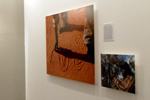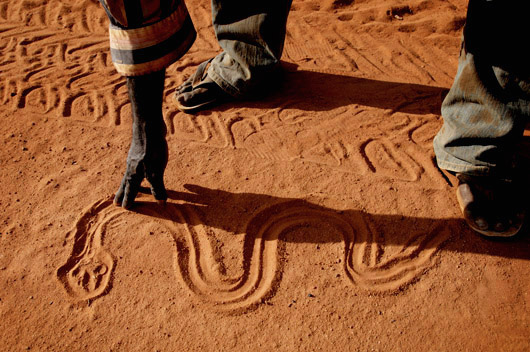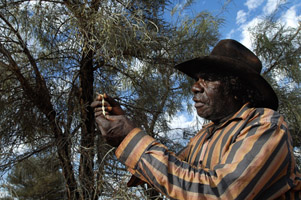Australia,
sulle tracce di Chatwin venti anni dopo Le Vie dei Canti
Palazzo Ducale, Genova
Australia, on Chatwin's footsteps twenty years
after The Songlines
Palazzo Ducale, Genoa


Ennesima
sosta per riempire il serbatoio a Ti Tree, dopo 1.300 km di strada. Si
avvicina un aborigeno, «my name is Heni». Sulla quarantina,
cappello scuro da mandriano, camicia a righe, jeans, infradito, pancia
da birra. Chiede un passaggio. Monta accanto, grato. Lavora in una “station”,
una grande fattoria con migliaia di animali qui vicino. A Ti Tree Arkady
e Chatwin si erano accampati accanto alla baracca di lamiera di un ex-marinaio
e sindacalista: Jack Clancy (nel libro Jim Hanlon), morto dieci anni fa.
Dalla biografia di Nicholas Shakespeare dedicata a Chatwin sembrava che
la sua “biblioteca comunista”, con i libri di Marx e Lenin
e la raccolta di poesie di Auden, potesse essere ancora lì, come
il caravan che ospitò Bruce e Arkady. Al posto della baracca c’è
una biblioteca con aborigeni che guardano dvd e giocano a videogame. Tra
l’erba alta si scorgono accampamenti miseri e auto abbandonate,
ma non la carcassa della vecchia Chevrolet di Clancy. Del passaggio di
Chatwin non c’è memoria, quelli che avevano conosciuto Clancy
sembra siano tutti ripartiti. Vent’anni in Australia sono tanti,
specialmente in questi posti di transito e frontiera. L’highway
fila dritta e monotona, come sempre. Heni è allegro, chiacchiera
molto. Parla di come spostano le mandrie, di eucalipti e querce del deserto.
Chiede di fermare, per mostrare i grandi buchi nella roccia dove da bambino
veniva a raccogliere l’acqua piovana. E racconta del suo Sogno,
quello del Serpente. Ne disegna la figura sulla terra rossa della pista.
Mostra l’apertura fra le colline dalla quale strisciò il
suo essere totemico, segue con la mano la via che percorse modellando
il mondo, indica l’orizzonte verso il quale si è diretto.
Recita gli eventi mitologici, il centro spirituale del proprio sé.
«It’s my dream», ripete, «my dream»
